Life, Matter, the Universe (part 5: historical importance of the the Miller–Urey experiment and the “RNA World”)
Submitted by Anonyme (non vérifié)“The molecule that came first is a molecule that can be both a gene and an enzyme. The answer to the evolutionary dilemma is RNA...”
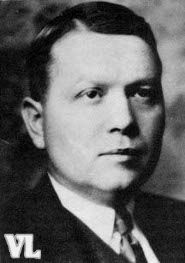 If we understand that we are the children of the sun, we have to understand how this process realized itself. How did it go from matter in movement? And what are living beings?
If we understand that we are the children of the sun, we have to understand how this process realized itself. How did it go from matter in movement? And what are living beings?
Let's begin with the organic compound. A first consideration that could logically be made is that without life, there are no organic compound. But this would not be dialectic. It would mean that the living beings would immediately exist with their characteristics, without a process. This would, so, be idealistic.
Alexander Ivanovich Oparin understood this. He looked at how the Earth must have looked like at its beginning.
The primitive atmosphere of the Earth was for him full of hydrogen, with oxygen combined to it in water vapor. Carbon was existing in the compound methane, nitrogen was present as ammonia.
And, related to this matter, there was energy, coming from the sun as ultraviolet radiation, coming from lightning as electric discharges, coming from volcano as heat.
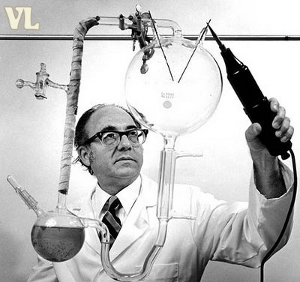
The American Harold Urey (1893 - 1981) followed Oparin. He also thought that the original atmosphere of the Earth was made of carbon, nitrogen, oxygen and sulfur, in their most reduced forms : carbon as methane, nitrogen as ammonium, oxygen as water and sulfur as hydrogen sulfide.
So, he tried an experiment: the famous Miller–Urey experiment from 1952, made with Stanley Miller (1930 – 2007).
This experiment is one of the highest importance for dialectical materialism. It breaks indeed with the idealistic thought that organic compounds are more than matter, that they exist only as “life”.
Both scientists took water (H2O), methane (CH4), ammonia (NH3) and hydrogen (H2). They put the water in a lower flask, the water being boiled, the vapor passing into the a upper flask where it mixed with methane, ammonia and hydrogen.
This mix was connected to a pair of electrodes, electric charges going through the mixture for one week, but with some cooling done to produce a system: what was simulated is evaporation (with the boiling of the water), lightning (through the electrodes), condensation (with the cooling).

The result after one week was the appearing of organic molecules, in a “soup” that also contained around 9 amino acids, 2% of the simplest, glycine and alanine, and traces of 7 others.
Here is a table, comparing the results of the Miller–Urey experiment with what was found in the Murchison meteorite, a 100 kilogram meteorite that fell on Australia in 1969.
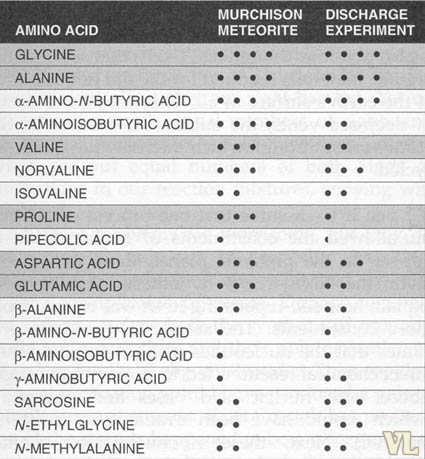
It is indeed not by chance that it was Harold Urey that coined the term “Cosmochemistry”. Logically, it makes understanding that the Earth belongs to the cosmos; the abundance of the chemical elements on Earth and on the stars belong to one cosmical process.
Let's look at the cosmic abundances of the most abundant elements:
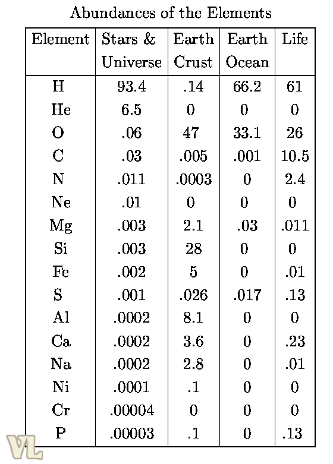
Here, another version to make it clear (ten most common elements in the Milky Way Galaxy estimated spectroscopically, mass fraction in parts per million) :
Hydrogen 739,000
Helium 240,000
Oxygen 10,400
Carbon 4,600
Neon 1,340
Iron 1,090
Nitrogen 960
Silicon 650
Magnesium 580
Sulfur 440
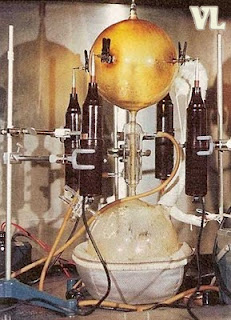 Let's quote here Clifford Matthews:
Let's quote here Clifford Matthews:
“Most striking is the fact that in this hydrogen-rich environment [of the Milky Way], the next most abundant elements (other than the inert gases helium, neon, and argon) are oxygen, carbon, and nitrogen.
The hybrides of these elements i.e. H2O [water], NH3 [ammonia], CH4 [methane] are among the many molecules so far detected in dense molecular clouds between and around stars, many of these having been formed by photochemical reactions around interstellar grains possessing inorganic and organic components.
These same four elements -H, O, C and N – are also the major components of living organisms, constituting 99,5 percent of the biosphere.” (Chemical Evolution in a Hydrogen Cyanide World, in: Environmental evolution)
The cosmic dimension of the question of matter is here very clear. Life can not be understood merely as a terrestrial phenomena.
The Miller–Urey experiment also opened the way to numerous others experiments, like the one made by Joan Oró in 1961, that found that amino acids could be made from hydrogen cyanide (HCN) and ammonia in a water solution, with the production also of the nucleotide base adenine, one of the four bases in RNA and DNA, and a component of ATP (a major energy releasing molecule in cells).
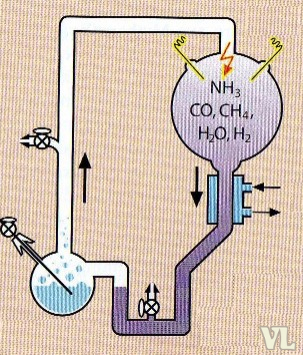 So, the compound are no “mystery”, but a result of the dialectical process of matter.
So, the compound are no “mystery”, but a result of the dialectical process of matter.
But what about life? We have organic compounds, but life exist with some characteristics: first it is a closed system, it is separated from its environment by an interface or a membrane. Secondly, it is able to metabolize, maintaining itself chemically. Thirdly, it is able to reproduce itself.
So how doest it go from the primordial soup to life? This is still the main question, but we know what the keys are: DNA, RNA and proteins.
Why that? Nowadays, in living beings, the DNA contains the genetic information, transcripting it to RNA, RNA translating the code in protein.
Here, RNA is the key informer, permitting the formation of proteins for the living cells. The code specifies the amino acid sequences of the proteins needed by a specific organism.
So, we can think that it came before the DNA, the DNA being the “safe” for the code, as the RNA is fragile (absorbing more ultraviolet radiation with the risk of genetic information damage; no proofreading...).
The RNA came also first, as it is able to catalyze reactions, DNA coming afterwards as a safe-mechanism. RNA can exist by itself, replicating itself and catalyzing. DNA needs RNA. DNA needs also deoxyribose, derived from ribose, whereas RNA needs ribose alone.
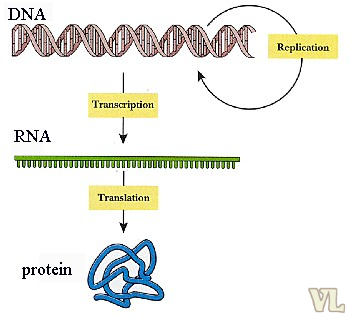
All of this formed the basis for the “RNA World” hypothesis, first used in 1986 by Walter Gilbert (born 1932, Nobel laureate in Chemistry).
“The molecule that came first is a molecule that can be both a gene and an enzyme. The answer to the evolutionary dilemma is RNA. The RNA World theory of evolution is that life originated from RNA”. (Walter Gilbert: The RNA World. Nature, 1986)
“The first stage of evolution proceeds, then, by RNA molecules performing the catalytic activities necessary to assemble themselves from a nucleotide soup.
The RNA molecules evolve in self-replicating patterns, using recombination and mutation to explore new niches. ... they then develop an entire range of enzymic activities.
At the next stage, RNA molecules began to synthesize proteins, first by developing RNA adaptor molecules that can bind activated amino acids and then by arranging them according to an RNA template using other RNA molecules such as the RNA core of the ribosome.
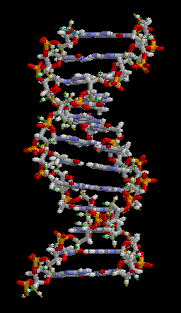 This process would make the first proteins, which would simply be better enzymes than their RNA counterparts. ... These protein enzymes are ... built up of mini-elements of structure.
This process would make the first proteins, which would simply be better enzymes than their RNA counterparts. ... These protein enzymes are ... built up of mini-elements of structure.
Finally, DNA appeared on the scene, the ultimate holder of information copied from the genetic RNA molecules by reverse transcription. ... RNA is then relegated to the intermediate role it has today—no longer the center of the stage, displaced by DNA and the more effective protein enzymes.” (Walter Gilbert: The RNA World. Nature, 1986)
Let's also quote James D. Watson about Francis Crick's thought (both are the co-discoverers of the structure of DNA in 1953):
“The time had come to ask how the DNA→ RNA→ protein flow of information had ever got started. Here, Francis [Crick] was again far ahead of his time. In 1968 he argued that RNA must have been the first genetic molecule, further suggesting that RNA, besides acting as a template, might also act as an enzyme and, in so doing, catalyze its own self-replication.” (Prologue: Early Speculations and Facts about RNA Templates)
But then, why not thinking that proteins came first? Because proteins are produced under the instructions of the DNA, and the DNA's replication is based on proteins.
So, there is the RNA, which is a key. To know to what is the key, is the question, and it is the question of the cell and of the bacterium.
